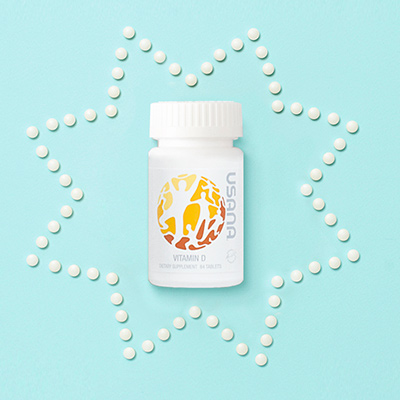The Truth About Vitamin D
In this blog, we are going to discuss the common misconceptions about Vitamin D that we have incorrectly learnt over the years from various sources. For decades, hearsay has circulated and misinformation has been compounded.
Do the following advice sound familiar?:
- Stay away from sun exposure or at the very least, slather on the sun cream
- Drink more milk (especially from cows) fortified with Vitamin D
- We do not need Vitamin D supplements as our body can make enough of its own
If the above examples hold true, why are there more than a billion people worldwide deficient in this critical Vitamin D despite the religious sunscreen use, milk consumption and not taking supplements?
Despite what its name suggests and what majority believe, Vitamin D is a fat-soluble hormone and not a vitamin. Our body produces this hormone when it is naturally exposed to the sun. Vitamin D in small amounts can also be absorbed via food intake.
It is important for our bodies to get enough of this fat-soluble hormone as Vitamin D participates in a number of different bodily processes. It helps to regulate gene expression, modulating inflammation and influencing our metabolic pathways. Curbing inflammation before it becomes chronic can also affect the body’s ability to sleep and renew energy.
The main source of Vitamin D is from the sun. Sunshine feeds our soul and quite literally nourishes our body by helping to create Vitamin D. However, you have to be committed to get all your Vitamin D from the sun. Not all of us live close enough to the equator during the prime time of year for optimal rays.
To be effective, we need to expose our bodies adequately to at least 20 minutes of especially the warmer morning or mid afternoon sunshine daily. Sadly, we have incorrectly been taught that the sun is our enemy and we need to avoid its rays at all costs. We incorrectly slather our skin in toxic chemicals found in sun cream that prevent the body from absorbing Vitamin D in its natural state.
Watch this video on our YouTube channel to learn more about what we have shared in a recent live recording.
An estimated 1 billion people worldwide are suffering from deficient or insufficient Vitamin D levels that lead to chronic disease, mainly because of the lack of sun exposure due to compulsive use of sunscreen or items like umbrellas to shade our bodies from the sun.
Taking a Vitamin D supplement daily is essential for great health. Ensuring the right one and quality is also vital. Vitamin D2 is the synthetic version of the Vitamin that can be found in many supplements and fortified foods. Vitamin D3 is the “sunshine” vitamin, which is the same one our skin absorbs from direct sun exposure and which has been researched extensively.
Vitamin D3 may help to relieve paid in sufferers of fibromyalgia, strengthen the heart in patients diagnosed with chronic heart failure, improve muscle growth and even increase lifespan.
When the sunshine vitamin meets Vitamin K2 (the primary form of the vitamin used by our tissues, bones and blood vessels), the “blood clotting” vitamin, radical transformation happens in the body. Vitamin K2 is the vitamin responsible for coagulation. It utilises our circulating calcium to help blood clot and stabilise.
Vitamin D3 and Vitamin K2, together manufacture and activate the Matrix GLA Protein in the body that helps to shield the arteries from calcification. This combination also maintains and strengthens our bones and teeth.
The brand we personally use and recommend can be ordered using this link
Taking one small tablet of the recommended supplement would be equivalent of drinking 14 cups of milk or eating four servings of salmon.
The fact that older people usually spend more time indoors due to lowered mobility, impacts vitamin D status.
Aging correlates to vitamin D deficiency in other ways:
- The skin loses its ability to absorb as much vitamin D as we get older.
- Our kidneys slowly become less effective at converting vitamin D from the sun into the form used by our body.
Skin Colour
Those with darker skin are at a higher risk for vitamin D deficiency because skin pigment has a direct correlation with how much vitamin D is made by the body. Research suggests that those with darker skin may need up to 10 times more sun exposure than those with lighter skin to produce a comparable amount of vitamin D.
Excessive Weight
Vitamin D is fat-soluble meaning that the fat in your body is how you collect and store it. So, if you’re overweight, the excessive amount of fat in your body needs a comparable amount of vitamin D to absorb. So, you’ll need a lot more vitamin D than someone with a lower percentage of body fat.
Gut Problems
Certain gut conditions that cause a lower absorption of fat can also lower your absorption of vitamin D.
You can add vitamin D to your daily meals with some foods. Fatty fish (salmon and trout), milk (dairy, almond, or soy), yogurt, egg yolks, fortified orange juice, and fortified cereals are sources of vitamin D. However, the amounts from these sources of foods are low.
It is tough to get enough sunshine for your body to make vitamin D. Depending on your habits, your daily food intake may not give you enough either. Fortunately, you can overcome the cloudy outlook about vitamin D. Most experts agree, supplements are a smart, safe way to increase your vitamin D.*
Key to Your Immunity
From long summer days to short wintry nights, your life never slows down and neither does your immune system.
Vitamin D can help keep you well, so you can keep up with your life, no matter the season. It supports a healthy, balanced immune system. It works throughout your body to preserve healthy function, including some places you might not think about when you consider immunity, like your skin.
The key role vitamin D plays in immune function is regulating and differentiating immune system cells. In other words, it helps to create specialized immune cells. It also helps control immune responses though cellular communication.
Receptors for vitamin D are found on most types of immune cells. When vitamin D binds to cellular receptors, it sends messages to help support many different natural responses that can help keep you healthy. Sometimes, those responses can include turning on production of even more active vitamin D to increase levels right where and when it’s needed.
How Much Vitamin D Do You Need?
When it comes to vitamin D recommendations, many experts believe the current Daily Recommended Intake (DRI) is significantly out of line with the science. The DRI set by the Food and Nutrition Board for most adults is only 15 mcg (600 IU) per day. However, much higher amounts are almost always needed to achieve optimal concentrations (40-60ng/mL) of 25(OH)D.
An in-house study conducted found that supplementation of up to 5,000 IU of vitamin D3 was necessary to reach the optimal level. That’s about 125 mcg per day. This amount lines up with the recommendation made by the Vitamin D Council.
The Signs of Low Vitamin D
The only way to know your vitamin D status for sure is to get a vitamin D test. But if you’re wondering what low levels of vitamin D might feel like, here are a couple signs to pay attention to:
- Feeling Down and Out
Running low on Vitamin D takes a pretty serious toll on your mood. This is because your brain produces serotonin, a hormone that affects mood at a higher rate when you’re exposed to sunshine or bright light.
2. Achy Bones and Joints
People who are unknowingly deficient in vitamin D might complain of low back pain. This could be related to weakened bones. Those with low levels of vitamin D may not absorb calcium and phosphorus efficiently, which, in turn, may impact bone mass.
Muscle cramps, pain, or weakness; fatigue; and hair loss have also been attributed to low levels of vitamin D. If you’re experiencing any of the above symptoms, talk to your doctor and ask for a test to check your vitamin D levels.
NEXT STEP
Book in a complimentary 15 minutes Zoom call with us (valued at £99) to enable us to clarify questions you may have on a specific health concern.






